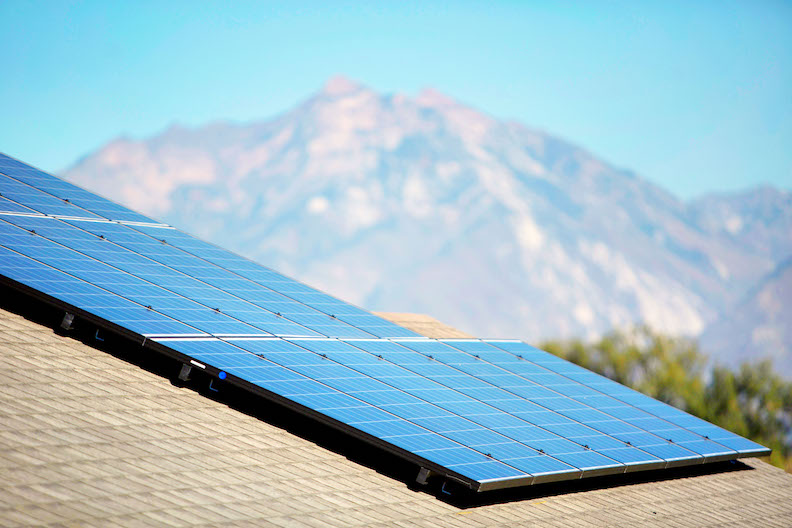Here at Shop Renewable Energy, we know that buying a solar system can be a big decision. That’s why we take the time and effort to walk every one of our prospective customers through the pros and cons of going solar for their unique situations. As a homeowner discovers the benefits of solar, they can have a lot of questions. One of the most common categories of questions we receive from potential solar system buyers and even recent owners are about the federal solar tax credit. We understand that these tax credits can be confusing, which is why in today’s post we will be covering everything you need to know about the solar tax credit. Whether it be what the solar tax credit is, why it exists, how much money it can save you, or whether you qualify, by the end of this five minute read you’ll know exactly how solar tax credits could make going solar a valuable investment for your family!

History of the Investment Tax Credit (ITC)
Since their conception in the early 70s, residential solar panels have always been one of the more promising renewable energy sources. Unfortunately, throughout their short history, they have been a more difficult power source for homeowners to adopt because of their high price. In order to help residential solar panels gain more adoption, the Energy Policy Act of 2005 was passed by the United States Congress and signed into law by President George W. Bush. The act’s main goals were to help the US become more energy efficient, rely more on renewable energy sources, and invest in new technologies that avoid by-production of greenhouse gases. One of the many contributions of the act was the first ITC or Solar Investment Tax Credit.

The original ITC allowed homeowners to claim 30% of the cost of their solar system as a credit on their federal tax return. At the time, the ITC had a cap of $2,000 in credit value and was set to expire in 2007. Luckily, the ITC was extended and changed under the Cantwell-Ensign Clean Energy Tax Stimulus Act of 2008, removing the $2,000 cap or limit. Because of its crucial success in helping homeowners decide to go solar, the ITC has been extended several times and is still valid through 2021 for residential homeowners. Despite its renewal, there are several important yearly changes to the tax credit that potential solar system buyers need to be aware of:
2019 – Last year that tax credit is 30% of the cost of the system.
2020 – Tax credit is reduced to 26% of the cost of the system.
2021 – Tax credit is reduced to 22% of the cost of the system.
2022 – Residential solar tax credit expires and no longer benefits system buyers.
Because of these changes, each year a homeowner waits to go solar, they miss out on thousands of dollars in potential savings. With huge savings available now, it’s important for customers to understand if they qualify for these tax credits.
What is a Tax Credit? And Do I Qualify for the Solar Tax Credit?
Before our customers go solar, we make sure that they understand the significance of a federal tax credit and whether or not they qualify for its savings. A federal tax credit is a dollar-for-dollar reduction to the federal income tax a person owes to the government. So, a $1,000 tax credit would allow a tax-paying US citizen to reduce their federal income tax by $1,000. In order to qualify for a federal solar tax, a solar buyer must:
- Have a federal tax liability
- Own their solar panels
- Own their home
If you have a federal tax liability, own the solar panels on your roof, and own your home, you likely qualify for a federal tax credit and thousands of dollars in savings on your panels.
Although these qualifiers might seem straightforward, there are some common misconceptions with each one of them.
3 Solar Tax Credit Myths:
- Federal tax credits are rebates or deductions
Federal tax credits are not rebates. A tax rebate is payable to a person even if that person does not pay taxes. On the other hand, a person can only use a federal tax credit if they have a federal income tax. Tax credits are also not tax deductions. A tax deduction lowers a person’s tax liability by lowering their taxable income. Thus, a tax deduction will not provide as much savings as a dollar-for-dollar tax credit. Once again, federal tax credits only apply to solar buyers who have a taxable income.
- Having solar on your roof is an automatic qualifier for an ITC
Many homeowners believe that having solar on their roof means that they automatically qualify for the solar tax credit. Unfortunately, this is not true. In order for a homeowner to qualify for an ITC, they must own the solar panels on their roof. Many homeowners get residential solar panels through PPA agreements or leasing deals. In these solar system agreements, the solar company owns the panels and sells the energy they produce to the homeowner. Thus, going solar through a leasing deal or PPA means that a homeowner does not own their panels and does not qualify for the federal tax credit.
- Renting a home with solar panels is eligible for a solar tax credit
Unfortunately, this simply isn’t true. A home renter with solar panels on their roof likely did not pay for the solar panels powering their home, meaning that they do not own them. So, there are no Solar Tax Credits available for renters.
How Much Do Solar Tax Credits Really Save?
Now that we have a clearer understanding of what the solar tax credit is and whether or not you qualify, it’s important to understand how much it can save you. Let’s take a look at two families who recently went solar:
The Garcia Family:
The Garcia family bought a solar system in February for $25,000. This means they are eligible for a $6,500 (26% of 25,000) federal tax credit. The Garcia’s will end up using this credit towards their $10,000 federal income tax and will only end up paying the IRS $3,500.
The Wilson Family:
The Wilson family bought the exact same system in January, which means that they are also eligible for a $6,500 credit. However, the Wilson’s have a lower income and only have to pay $4,500 in federal income taxes to the IRS. When they apply their $6,500 credit, only $4,500 will be claimed because they only paid that much in taxes. Luckily, any unused credit will roll over to the next year, meaning that the Wilson’s will still have $2,000 in federal tax credit next year.
By looking at these two families, we can see that the solar tax credit allows families and homeowners to save thousands of dollars in the long run. At Shop Renewable Energy, we encourage our customers to apply their savings from their tax credit to their solar loan (if they financed their solar system). By doing so, they’ll be able to save the most money in the long run and be that much closer to owning their system outright.
Applying for Your Solar Tax Credit!
Savings are always great but applying for a tax credit can be a little intimidating. Many of our customers do not know where to start or how to get the ball rolling before it’s too late to apply. In order to claim your solar tax credit, you will need to complete a form 5695. To make filling out this document as simple as possible, we have created a simple 6-step guide:
- Download form 5695.
- On line 1, fill in the cost of your system as it is listed on your final invoice.
- Fill in line 5 and 6. Line 6 should match the amount of your federal tax credit as it was listed on your proposal.
- Fill in any other parts of the form if you have additional residential energy credits for which to apply.
- Fill in line 16 only if you do not have the tax liability to use the entire credit this year and want some to roll over to next year.
- File this form with your federal taxes.
If you want more details, feel free to visit our Solar Tax Credits page where you can download more in-depth instructions on filling out your 5695 form. For questions related specifically to your tax situation, we recommend working with a tax professional.
Shop Renewable Energy Cares about our Customers!
If you made it this far into the post, you are officially an expert on all things solar tax credits. You probably have also realized that there is no better time to go solar than now. With these government incentives disappearing, every year you wait to go solar means thousands of dollars lost in savings. At Shop Renewable Energy, it is our mission to make your solar journey as pain free and simple as possible. That is why we invite homeowners to estimate their solar savings. By simply entering your name, email, phone number, and zip code, we will be able to get you connected to one of our solar specialists, who can estimate your savings and help you decide if solar is right for your unique situation and home. Don’t miss out on this free consultation! Click on the link below to see how much you can save!
Tune in next week to learn more about specific state benefits that could mean even more savings for your solar system! If you have any more questions on solar tax credits, feel free to leave a comment and we’ll help you with any questions that you might have!
